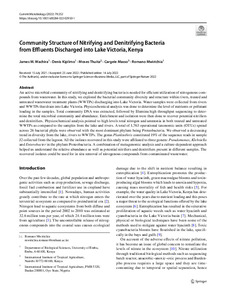| dc.contributor.author | Wachira, J.M. |
| dc.contributor.author | Kiplimo, D. |
| dc.contributor.author | Thuita, M. |
| dc.contributor.author | Masso, C. |
| dc.contributor.author | Mwirichia, R. |
| dc.date.accessioned | 2022-12-02T14:05:25Z |
| dc.date.available | 2022-12-02T14:05:25Z |
| dc.date.issued | 2022 |
| dc.identifier.citation | Wachira, J.M., Kiplimo, D., Thuita, M., Masso, C. & Mwirichia, R. (2022). Community structure of nitrifying and denitrifying bacteria from effluents discharged into Lake Victoria, Kenya. Current Microbiology, 79(9):252, 1-10. |
| dc.identifier.issn | 0343-8651 |
| dc.identifier.uri | https://hdl.handle.net/20.500.12478/7956 |
| dc.description.abstract | An active microbial community of nitrifying and denitrifying bacteria is needed for efficient utilization of nitrogenous compounds from wastewater. In this study, we explored the bacterial community diversity and structure within rivers, treated and untreated wastewater treatment plants (WWTPs) discharging into Lake Victoria. Water samples were collected from rivers and WWTPs that drain into Lake Victoria. Physicochemical analysis was done to determine the level of nutrients or pollutant loading in the samples. Total community DNA was extracted, followed by Illumina high throughput sequencing to determine the total microbial community and abundance. Enrichment and isolation were then done to recover potential nitrifiers and denitrifiers. Physicochemical analysis pointed to high levels total nitrogen and ammonia in both treated and untreated WWTPs as compared to the samples from the lake and rivers. A total of 1,763 operational taxonomic units (OTUs) spread across 26 bacterial phyla were observed with the most dominant phylum being Proteobacteria. We observed a decreasing trend in diversity from the lake, rivers to WWTPs. The genus Planktothrix constituted 19% of the sequence reads in sample J2 collected from the lagoon. All the isolates recovered in this study were affiliated to three genera: Pseudomonas, Klebsiella and Enterobacter in the phylum Proteobacteria. A combination of metagenomic analysis and a culture-dependent approach helped us understand the relative abundance as well as potential nitrifiers and denitrifiers present in different samples. The recovered isolates could be used for in situ removal of nitrogenous compounds from contaminated wastewater. |
| dc.description.sponsorship | International Institute of Tropical Agriculture |
| dc.description.sponsorship | National Research Fund, Kenya |
| dc.description.sponsorship | The Alexander von Humboldt Equipment Grant |
| dc.format.extent | 1-10 |
| dc.language.iso | en |
| dc.subject | Community |
| dc.subject | Bacterial Diseases |
| dc.subject | Kenya |
| dc.title | Community structure of nitrifying and denitrifying bacteria from effluents discharged into Lake Victoria, Kenya |
| dc.type | Journal Article |
| cg.contributor.affiliation | University of Embu |
| cg.contributor.affiliation | International Institute of Tropical Agriculture |
| cg.coverage.region | Africa |
| cg.coverage.region | East Africa |
| cg.coverage.country | Kenya |
| cg.coverage.hub | Central Africa Hub |
| cg.researchtheme | Natural Resource Management |
| cg.identifier.bibtexciteid | WACHIRA:2022a |
| cg.isijournal | ISI Journal |
| cg.authorship.types | CGIAR and developing country institute |
| cg.iitasubject | Agronomy |
| cg.iitasubject | Biodiversity |
| cg.iitasubject | Disease Control |
| cg.iitasubject | Soil Fertility |
| cg.journal | Current Microbiology |
| cg.notes | Open Access Article; Published online: 14 Jul 2022 |
| cg.accessibilitystatus | Open Access |
| cg.reviewstatus | Peer Review |
| cg.usagerightslicense | Creative Commons Attribution 4.0 (CC BY 0.0) |
| cg.targetaudience | Scientists |
| cg.identifier.doi | https://dx.doi.org/10.1007/s00284-022-02950-1 |
| cg.iitaauthor.identifier | Moses Thuita: 0000-0002-6731-9492 |
| cg.iitaauthor.identifier | Cargele Masso: 0000-0002-3980-6832 |
| cg.futureupdate.required | No |
| cg.identifier.issue | 9 |
| cg.identifier.volume | 79 |

